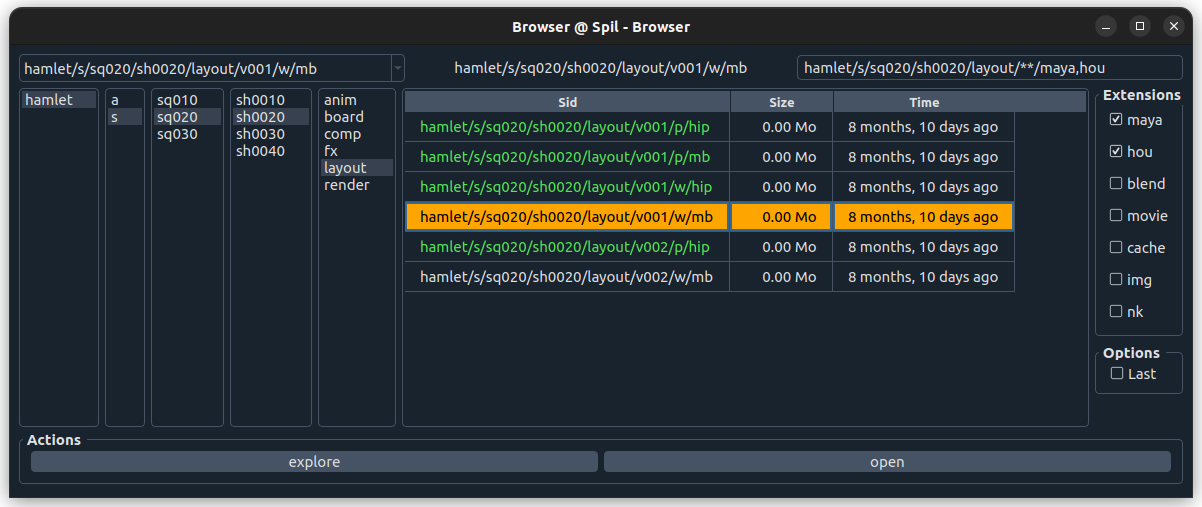Spil provides a simple, hierarchical, path-like, unique identifier for every entity or file of a CG production pipeline.
An intuitive API is built around this identifier, including glob-like search, CRUD data access and path resolving.
Spil was created to:
- uniquely and intuitively identify all entities of a pipeline.
- aggregate different data sources (file systems, asset manager, DCCs, etc.)
- have a universal, versatile and lightweight "Entity" object for pipeline operations, at a higher abstraction level than a file path.
- propose an easy and intuitive API, to empower TDs and technical artists to connect to the pipeline.
Full documentation: spil.readthedocs.io.
The identifier is called the "Sid" - for "Scene Identifier".
Examples:
- Sid of sequence 30 shot 10 in the project "Hamlet":
"hamlet/s/sq030/sh0010"
- Sid for the maya mb file of character Ophelia's modeling, published version v002:
"hamlet/a/char/ophelia/modeling/v002/p/mb"
Once resolved, the Sid is a dictionary associated to a type. Keys and types are fully configurable.
Examples:
- type
shot__task:
{
'project': 'hamlet',
'type': 's',
'sequence': 'sq030',
'shot': 'sh0010',
'task': 'animation'
}
- type
asset__version:
{
'project': 'hamlet',
'type': 'a',
'cat': 'props',
'name': 'skull',
'task': 'modeling',
'version': 'v008'
}
Sid creation and manipulation
from spil import Sid
# create a Sid from scratch
task = Sid("hamlet/s/sq030/sh0010/render")
# a task sid: hamlet/s/sq030/sh0010/render
# create a Sid by changing values
anim_task = task.get_with(task="anim")
# task sid: hamlet/s/sq030/sh0010/anim
# create a Sid from a Sids hierarchy
sequence = task.get_as('sequence')
# sequence sid: hamlet/s/sq030
# another way
shot = task.parent
# shot sid: hamlet/s/sq030/sh0010 Creation with a uri-query or dictionary
from spil import Sid
seq = Sid(query="project=hamlet&type=s&sequence=sq010") # uri-query
seq = Sid(fields={'project': 'hamlet', 'type': 's', 'sequence': 'sq010'}) # dictData can be accessed in multiple ways: by key, as a complete dictionary, as string or uri-query.
from spil import Sid
shot = Sid("hamlet/s/sq030/sh0010")
# get a field of the sid by key
shot.get("sequence")
# sq030
# as a dictionary
shot.fields
# { 'project': 'hamlet', 'type': 's', 'sequence': 'sq030', 'shot': 'sh0010' }
# as a Query
shot.as_query()
# "project=hamlet&type=s&seq=sq030&shot=sh0010"
# "uri": type and string
shot.uri
# "shot__shot:hamlet/s/sq030/sh0010" The Sid can be resolved to and from paths.
Multiple configurations can co-exist.
For example "local", "server", "linux", etc. paths.
from spil import Sid
# creating a Sid from path
scene = Sid(path="/projects/hamlet/chars/ophelia/modeling/v002/publish/ophelia_model.mb")
print(scene)
# "hamlet/a/chars/ophelia/modeling/v002/p/mb"
# returning default path
path = scene.path()
# "/projects/hamlet/chars/ophelia/modeling/v002/publish/ophelia_model.mb"
# returning path from "server" configuration
path = scene.path("server")
# "/server/projects/hamlet/chars/ophelia/modeling/v002/publish/ophelia_model.mb"Example in maya, with an opened scene file:
import maya.cmds as cmds
from spil import Sid
# Get the current scene's path
scene_path = cmds.file(query=True, sceneName=True)
# build the Sid
scene = Sid(path=scene_path)
if scene: # A sid that is not resolvable (not conform), has no type, and evaluates to False.
print(scene.get('project')) # hamlet
print(scene.get('version')) # "v002"
else:
print("opened scene is not a pipeline scene")Sid wraps common requests, that are delegated to configurable data sources (Finder and Getter).
from spil import Sid
task_sid = Sid("hamlet/s/sq030/sh0010/layout")
task_sid.exists() # True
task_sid.get_last('version') # "hamlet/s/sq030/sh0010/layout/v003"Sids API can intuitively express common pipeline workflows.
from spil import Sid
task_sid = Sid("hamlet/s/sq030/sh0010/layout")
if task_sid.exists():
print( task_sid.get_last('version').get_attr('comment') ) # "Changed camera angle."
# match() is handy for hooks and action overrides
if task_sid.match('hamlet/s/*/*/layout/**/maya'):
# do something specific for hamlet maya layouts
... Considering the Sid a middleware and data abstraction layer, Spil proposes an intuitive glob-like search syntax.
It is string based, and uses operators:
- * : star search
- ** : recursive star search
- > : last
- , : "or"
- configurable aliases ("movie" -> "mov,avi,mp4", "maya" -> "ma,mb")
- "All the Shots of sequence sq030" ?
"hamlet/s/sq030/*"
- "All the published maya files of Ophelias modeling" ?
"hamlet/a/chars/ophelia/model/*/p/maya"
- "Last published render movies for the project hamlet" ?
"hamlet/s/**/render/>/p/movie"
- "All cache files for hamlet's sequence 30, shot 10" ?
"hamlet/s/sq030/sh010/**/cache"
Query Syntax can be used to add search filters on yet untyped searches
- "All published Movie files for hamlet's sequence 30" ?
"hamlet/s/sq030/**/movie?state=p"
- "All published hip files for hamlet's sequence 30, animation or layout" ?
"hamlet/s/sq030/**/hip?state=p&task=animation,layout"
To launch search queries, Spil implements Finder classes that access different data sources.
- FindInPaths: to search the file system
- FindInList: to search a list
- FindInCache: to search a cache
- FindInAll: to search other Finders, depending on a configuration
- FindInShotgrid: to search Shotgrid
All Finders implement find(), find_one() and exists().
# Look up the last published versions for given shot, on the File System
from spil import FindInPaths as Finder
for sid in Finder().find("hamlet/s/sq010/sh0010/**/>/p/movie"):
print(sid)
# "hamlet/s/sq010/sh0010/layout/v012/p/mov"
# "hamlet/s/sq010/sh0010/animation/v003/p/avi"
# "hamlet/s/sq010/sh0010/render/v001/p/mov"
# ...The FindInShotgrid is an example Finder implementation.
It may need to be adapted, depending on the production's Shotgrid usage.
It is planned to implement other Finders, for example for MongoDB and CGWire kitsu.
Spil can be used with the spil_ui.browser.
Spil_UI is a Qt browser UI, built on top of QtPy (PySide2/PySide6).
Navigating through the columns builds a "Search Sid" and calls a Finder.
It is possible to run custom and configurable actions on the currently selected Sid.
spil_ui is a separate repository.
Spil can run server side.
(REST API and docker under development)
Spil is a library, not a framework.
It is fully configurable. It adopts your naming conventions, and does not enforce specific workflows.
It easily integrates and connects onto existing pipelines.
The Sid is based on the resolva resolver.
Sid config example:
'asset__file': '{project}/{type:a}/{assettype}/{asset}/{task}/{version}/{state}/{ext:scenes}',
'shot__file': '{project}/{type:s}/{sequence}/{shot}/{task}/{version}/{state}/{ext:scenes}',
'shot__movie_file': '{project}/{type:s}/{sequence}/{shot}/{task}/{version}/{state}/{ext:movies}',
Paths config example:
'asset__file': '{@project_root}/{project}/PROD/{type:ASSETS}/{assettype}/{asset}/{task}/{version}/{assettype}_{asset}_{task}_{state}_{version}.{ext:scenes}',
'shot__file': '{@project_root}/{project}/PROD/{type:SHOTS}/{sequence}/{sequence}_{shot}/{task}/{version}/{sequence}_{shot}_{task}_{state}_{version}.{ext:scenes}',
'shot__movie_file': '{@project_root}/{project}/PROD/{type:SHOTS}/{sequence}/{sequence}_{shot}/{task}/{version}/EXPORT/{sequence}_{shot}_{task}_{state}_{version}.{ext:movies}',
The Data Source is configurable depending on the given Sid or Sid type.
'project': finder_projects,
'shot_task': FindInShotgrid(),
'default': FindInPaths(),
Spil works in Python >=3.7.
Spil is available on pypi and can be installed using pip install spil.
To install with the UI, use pip install spil_ui.
More about installation, configuration and testing: spil.readthedocs.io.
Spil thrives to be used interactively.
It's performance depends on the data sources that are used.
- Spil uses a
FindInConstantsclass to handle configurable data that mostly doesn't change (types, asset types) - Spil ships with a configurable
FindInCacheclass to handle data that changes rarely (projects, sequences, assets, etc.). (not production ready in current release) - Pattern regex-compiles are instance cached
- String Resolves are internally stored in a custom lru_cache
Findersuse generators
Spil builds upon general concepts, as well as production proven CG pipeline concepts.
-
Unique Identifier - Human readable Identifier - "Natural Key"
dzone.com/articles/7-strategies-for-assigning-ids-to-microservices
medium.com/blue-sky-tech-blog/a-rose-by-any-other-name-4b569309b575 -
Python File system path
www.python.org/dev/peps/pep-0428 -
Query by Example
A query technique where "example" entities, with search values, are used to retrieve "matching" results.
en.wikipedia.org/wiki/Query_by_Example -
Node tree & hierarchy
-
Unique Identifier & Resource Locator, as seen in:
- Blue Sky's "Pipeline Resource Identifier (PRI)"
- Sony Pictures "SPREF"
- Animal Logic USD Asset Resolver URIs
- OpenAssetIO's Entity Reference
-
Resource description and "Context" (Shotgrid Toolkit)
developer.shotgridsoftware.com/tk-core/core.html#context -
the "TypedContext", an entity for hierarchical types in Ftrack
-
Template based path resolving
As implemented in Shotgrid Toolkit:
github.com/shotgunsoftware/tk-config-default/blob/master/core/templates.yml
By CGWire's kitsu zou.cg-wire.com/file_trees
By Lucidity or resolva -
Middleware between Asset consumers or producers
OpenAssetIO
Katana Asset API -
Asset Resolution - ArResolver - in USD
https://openusd.org/release/api/ar_page_front.html -
The Sid itself
The Sid has been used in general and fx pipelines since 2011, in various implementations and at various degrees.
Spil aims to be : flexible, pragmatic, simple - and reliable.
- flexible
Spil is a library, and not a framework.
It can be plugged to existing pipelines. It easily blends in, to be used only where it is needed.
It can also be planned at a pipelines core - and be a central part of it.
- pragmatic
It all starts as files. So does Spil.
YAGNI meets WYSIWYG.
- simple
Complexity costs money, at all levels of a pipeline.
Spil aims at simplicity, even at the price of some universality or adaptability.
Usage is intuitive: it is obvious thathamlet/a/charis an asset category, andhamlet/a/char/ophelia/modelingis a modeling task.
Producers have an overview, artists see clearly, TDs are empowered.
That is the goal of Spil.
- reliable
This part is yet to prove.
"In the face of ambiguity, refuse the temptation to guess."
But who are you to have read this far anyway?
-
The configuration is tricky
For complex projects, creating the config is not simple, and is lacking tools to help.
Complex configurations may not work out of the box -
Beta stage
The core concepts have been around for a while, and different versions of the Sid are and have been used in production pipelines for some time now.
But this version of "Spil" is a rewrite. It is currently used in production, but is still young. -
Needs optimisation
The resolver is fast (using caches and memoization), but would benefit from a faster rust implementation.
File sequence support (eg. image sequences using fileseq) is still very slow.
The priority is to make the current feature set more robust, efficient, and easy to deploy.
- tools to help create and verify the configuration files
- more testing and profiling
- rust implementation of resolva
To take profit from the Sids universality, we plan on building reusable open source bricks and pipeline tools.
For example:
- protocol for pipeline actions, for example
sid://play?hamlet/s/sq030/**/>/p/movie - connectors to Shotgrid, CGWire Kitsu, Ftrack and Databases
- using the sid as a USD Asset Resolver / In a USD pipeline
- GraphQL and/or rest API
- file system style navigation and context handling
For examplecd hamlet/s/sq010
We'd love to hear from you.
We are interested in any kind of feedback: comments, questions, issues, pull requests.
Spil is released under LGPL and is usable in closed source commercial applications. Other licensing is possible, please get in touch.
Don't hesitate to contact us : spil@xeo.info.
We will be happy to respond.





